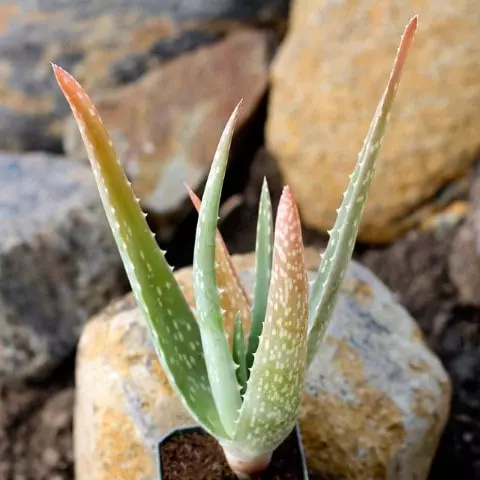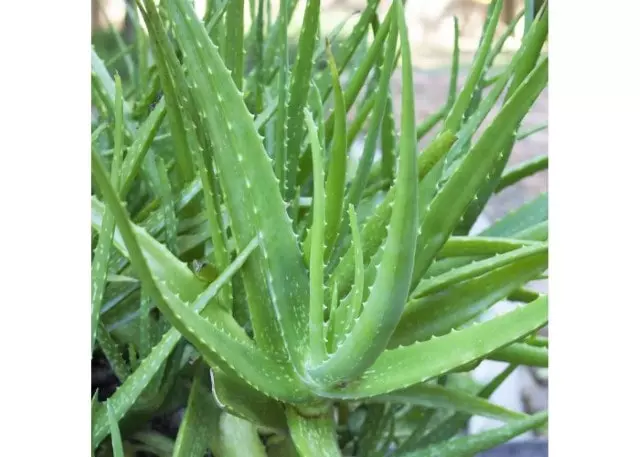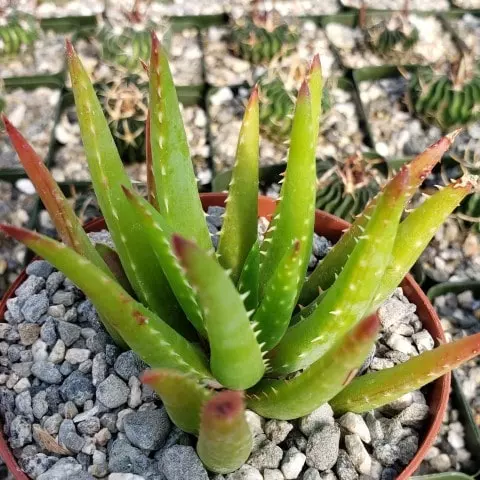Aloe vera Chinensis is one of the most famous and easy to care for varieties of the Aloe genus. Moreover, thanks to its ease of propagation, you can get it almost anywhere in the world.
Aloe vera Chinensis is very reminiscent of Aloe barbadensis miller. It looks like a smaller version with many more leaves, although the differences do not stop there:
1- Chinensis leaves are thinner and are borne differently.
2- It has many white spots on both sides of the leaves, regardless of their age.
3- Chinensis Aloe produces many more offshoots from an early age.
4- Its flowers are orange.
Table of Contents
Origin and Habitat Aloe vera Chinensis
Guessing where a plant like Aloe vera Chinensis originated is complicated by how widespread it is worldwide today. When a plant is conserved in only one area of the world, it becomes easier to be sure that it probably originated there as well.
If you have to assign an area as more certain as to its origin, that is North Africa and the islands in the northwest of the continent.
As it has now spread with great ease to temperate and tropical zones throughout the world, it is believed that it may have originated in Southern Africa.
- 100% SATISFACTION GUARANTEE: What makes us different is the passion and the attention to the detail on all we do here at Planet Desert. We are confident in the quality of our products, and that’s why all our plants have a 100% satisfaction guarantee! If you are not satisfied with your purchase, you can return the product and get a full refund or exchange the product for another one, be it similar or not.
- HAND SELECTED AT OUR CALIFORNIA NURSERY: Planet Desert is a family-owned wholesale/retail nursery based in Southern California. Every plant is specially selected, handpicked and carefully packed to guarantee that you will receive the best quality plants. We are dedicated to growing a wide variety of eye-catching cacti and succulents and are constantly adding, developing, and creating more products!
- UNIQUE GIFTS: We have brought together some of our favorite succulents, and an exclusive selection of cacti to create a unique experience. Whether you want to send a birthday present, surprise a friend, or just send a message to someone you love, it is the perfect gift for everyone from plant enthusiasts to beginners.
Description of Aloe vera Chinensis
Like any of its relatives in the genus Aloe, this variety builds its wingspan through overlapping rosettes.
An adult Aloe Chinensis develops about 18 triangular leaves per year with maximum lengths of 12″ (30 cm). Its triangular shape is much more elongated than any of its close relatives.

What Do Rosettes Look Like?
Because of the plant’s rapid growth, it builds many more three-leaf rosettes than any other Aloe variety.
The plant can reach a height of up to 3.2 ft (1 m) due to the number of overlapping rosettes, which stretch the stem in a very short time.
What Are the Leaves Like?
We could speak of two types of aloes; those with white specks on their leaves and those with white specks on their leaves. This succulent belongs to the group of aloes with white spots on its leaves, being the variety with probably the most spots of all.
As another curiosity about Chinensis Aloe, I could add that its leaves have a more intense and brighter green due to the lack of pruning. Many websites say that it has bluish-grayish tones, but this does not happen if it is not excited by sunlight.
Aloe vera Chinensis Flower
As I said before, many people confuse Aloe vera Chinensis with Barbadensis, however, the flowers of Aloe vera Chinensis can be used to differentiate the two.
The bell-shaped flowers of Aloe vera Chinensis are yellow/orange, while Barbadensis is bright yellow.
As for the size of the flowers, like other varieties they rise to one meter (3.2″) in height, grouped in clusters and opening from the bottom upwards. The size does not exceed 1.2″ (3 cm) in the largest specimens.

Aloe vera Chinensis vs Barbadensis
Many people wonder what is the difference between Aloe vera Chinensis vs Barbadensis, they are totally different species. A scientific study proved that these two species are totally different.
The scientific study analyzed four species of Aloe with medicinal properties and found that the four had different amounts of protein, which helps to differentiate that they are different species.
Cultivation and Propagation Aloe vera Chinensis
Like most Aloes, this variety is widely cultivated both indoors and outdoors for its decorative value. Together with its rapid growth and the number of sprouts it produces, it has spread very fast worldwide.
Those aloes or succulents in general, which have more accelerated growth, are usually more resistant and tolerant to extreme temperatures as well as excessive or scarce watering.
If you get a plant of this variety in a very short time, you will see your house full of sprouts.

Soil Aloe vera Chinensis
Again I have to warn that the substrate conditions are the same as any other aloe, except that the Aloe vera Chinensis tolerates less loose soils because an excess of water retention will not always harm this variety. This is because while it develops more foliage, it also develops many more roots. Learn more about Best Soil for Aloe vera.
- Growing indoors is easy under the right conditions; Miracle-Gro Houseplant Potting Mix combines key elements plants need to thrive
- Recommended for growing beautiful indoor houseplant varieties like Pothos, Spider Plants, Monstera, Philodendron, English Ivy and more
- This indoor plant soil is less prone to gnats, thanks to the combination of perlite, sphagnum and peat moss that's just right
Watering Aloe vera Chinensis
Proceed to water these plants using the soaking and drying method and to obtain the best possible results.
You will notice that in the case of this variety, the soil dries out much earlier than in others. This is due to its great capacity to develop roots and retain water in the leaves.
Special Needs Aloe Chinensis
While in other varieties, it is not advisable to change or enlarge the pot until two years of age, in the case of Aloe Chinensis it is good to enlarge the pot every spring and remove all the young shoots.
Light Aloe vera Chinensis
Sorry if I repeat myself too much, but like all fast-growing succulents, this one needs at least 6 hours of good lighting a day, or it will start to stretch and grow deformed.
Hardiness Aloe vera Chinensis
Aloe Chinensis is not a particularly hardy plant, at least not more so than its close varieties. My advice is to protect it from extremes, as both direct sun and intense cold can burn its tips or younger plants completely.
Uses Aloe Chinensis
This aloe is used purely as a decorative or medicinal plant for topical use. There is not enough evidence or experience to say that it can be ingested. The only variety I ingest is Barbadensis Miller.
Propagation Aloe vera Chinensis
It seems obvious that a plant that gives us dozens of sprouts a year, has as its main method of reproduction the extraction of these shoots.
Another alternative when a plant has developed a lot is the extraction of stems; this is to cut the stem leaving leaves at the base, let the cut dry, and replant.
If you like Aloe plants, we recommend our article about Aloe Plant Turning Brown.



